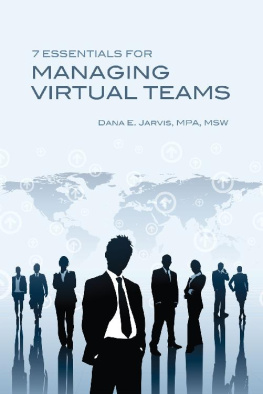Dana Jarvis - 7 Essentials For Managing Virtual Teams
Here you can read online Dana Jarvis - 7 Essentials For Managing Virtual Teams full text of the book (entire story) in english for free. Download pdf and epub, get meaning, cover and reviews about this ebook. genre: Business. Description of the work, (preface) as well as reviews are available. Best literature library LitArk.com created for fans of good reading and offers a wide selection of genres:
Romance novel
Science fiction
Adventure
Detective
Science
History
Home and family
Prose
Art
Politics
Computer
Non-fiction
Religion
Business
Children
Humor
Choose a favorite category and find really read worthwhile books. Enjoy immersion in the world of imagination, feel the emotions of the characters or learn something new for yourself, make an fascinating discovery.
- Book:7 Essentials For Managing Virtual Teams
- Author:
- Genre:
- Rating:4 / 5
- Favourites:Add to favourites
- Your mark:
- 80
- 1
- 2
- 3
- 4
- 5
7 Essentials For Managing Virtual Teams: summary, description and annotation
We offer to read an annotation, description, summary or preface (depends on what the author of the book "7 Essentials For Managing Virtual Teams" wrote himself). If you haven't found the necessary information about the book — write in the comments, we will try to find it.
7 Essentials For Managing Virtual Teams — read online for free the complete book (whole text) full work
Below is the text of the book, divided by pages. System saving the place of the last page read, allows you to conveniently read the book "7 Essentials For Managing Virtual Teams" online for free, without having to search again every time where you left off. Put a bookmark, and you can go to the page where you finished reading at any time.
Font size:
Interval:
Bookmark:
7 Essentials for Managing Virtual Teams
![]()
By Dana Jarvis
Duquesne University

Bassim Hamadeh, CEO and Publisher
Kassie Graves, Director of Acquisitions and Sales
Jamie Giganti, Senior Managing Editor
John Remington, Acquisitions Editor
Natalie Lakosil, Licensing Manager
Kaela Martin, Project Editor
Berenice Quirino, Associate Editor
Copyright 2018 by Dana E. Jarvis. All rights reserved. No part of this publication may be reprinted, reproduced, transmitted, or utilized in any form or by any electronic, mechanical, or other means, now known or hereafter invented, including photocopying, microfilming, and recording, or in any information retrieval system without the written permission of Cognella, Inc. For inquiries regarding permissions, translations, foreign rights, audio rights, and any other forms of reproduction, please contact the Cognella Licensing Department at rights@cognella.com.
Trademark Notice: Product or corporate names may be trademarks or registered trademarks, and are used only for identification and explanation without intent to infringe.
Cover image copyright Depositphotos/cienpies.
Printed in the United States of America
ISBN: 978-1-5165-2348-1 (ebk) / 978-1-5165-1859-3 (pbk)

DEDICATION
This book is dedicated to Mom, Dad, Michelle, Sydney and Gavin.
I love you always and forever, to infinity and beyond.
Virtual reality, virtual space, virtual organizations, virtual teams; the word virtual is todays organizational buzzword. Virtual is there but not there, and this is exactly what Alice experienced with the Cheshire Cat in Wonderland. So, the virtual world really is not as new an idea as some of us might have thought. One of the fastest-growing, high-tech office trends today is virtual teams. These teams cross time, space, and cultural boundaries and do so effectively with the use of technology. When Marshall McLuhan forecasted the global village in the 1960s, he was, in fact, speaking of the virtual workplace (Johnson, Heimann and ONeill, 2001, p.24). Today, a Google search of virtual teams yields 704,000,000 results. It is amazing to think about how far we have come in developing and deploying virtual teams. In many ways, virtual teams have become a major part of our organizational landscape.
Prasad and Akhilesh (2002) in their research share that:
It no longer matters to Microsoft if some of its product designers are sitting in one part of the USA, its product development engineers in a different part and product test engineers in some other part of the world, for example China or India. Texas Instruments has offices spread across the world (including the USA and India) and interestingly, some of the teams, irrespective of their location, use the same computing infrastructure like servers and development tools. With the time differences of as high as 12 hours in some cases, when one team is probably leaving office for home, the other teams are just coming in, thus leading to high resource utilization. Similar is the case with Motorola, where the multiple teams are working together from different parts of the globe on a single product. Organizations are excited by the fact that they no longer need to co-locate big teams. Microsoft, Texas Instruments and Motorola are just examples. Looking around, it is not difficult to see a majority of the multi-national organizations operating such teams with product design, development, test centers distributed around the globe, Philips, Ericsson, Hewlett-Packard, Honeywell, GE, DaimlerChrysler, Oracle and Digital Equipment just to name a few (pp. 102-103).
Based on the research, there are a number of significant reasons for companies choosing to have virtual teams. Johnson, Heimann and ONeill (2001) provide a concise list of benefits associated with the benefits of virtual teams. These include:
* Allows flexible hours so employees can spend more time with family. Nearly 75 percent of teleworkers responding to an AT&T survey last year said that they were more satisfied with their personal and family lives [now] than before they started working (Baig and Dunkin, 1998).
* Creates and disperses improved business processes across organizations.
* Supports cross-functional and cross-divisional interaction.
* Saves time and money in the daily transportation to and from work.
* Reduces pollution. If 10 percent of the US workforce telecommuted one day a week, the population would avoid the frustration of driving 24.4 million miles, would breathe air with 12,963 tons less air pollution, and would conserve more than 1.2 million gallons of fuel each week (Langhoff, 1999).
* Changes from a production-oriented company to a service/ information-oriented company (Baig and Dunkin, 1998).
* Helps physically challenged people who could not work in a traditional environment be crucial members of companies via telecommunications (Gould, 1999).
* Reduces restrictions on working hours.
* Requires less office and parking space.
* Reduces costs of heat and electricity (pp. 25-26).
Clearly, there is a need for virtual teams within our expanding global economy. In order to build on the concept of a virtual team, it is first necessary to outline characteristics of high performing teams versus those that are not. What are the characteristics of a high impact team? Why do some teams fail to meet their goals? In what ways are these types of teams similar and different? These are the driving questions required to spark our virtual team to greatness. Greatness can be measured in the team serving as a legacy for those behind them. An example is the 1970s Pittsburgh Steelers football dynasty.
Growing up in Pittsburgh, PA, we are taught early on that the Pittsburgh Steelers are a part of our lifestyle, community and identity as a city. In the 1970s, Head Coach Chuck Noll proved himself to be a no nonsense type of leader. Under his direction, the Steelers won 4 Super Bowls. No other team at that time had ever won as many Super Bowls. One of the defining characteristics of the team was a strong work ethic in which Coach Noll would do his part and the team would do their part. Noll once said, The key to a winning season is focusing on one opponent at a time. Winning one week at a time. Never look back and never look ahead. Underlying his words is the realization that it took the entire team to work as a cohesive group to win an unbelievable 4 Super Bowls in the 1970s. These are defining moments of greatness that have served as a legacy for teams who have followed.
Upon further analysis of Super Bowl Championship teams like the Pittsburgh Steelers, a number of high performing characteristics emerge. These are matched by low performing teams exemplified by a failure to develop goals, failure to execute on goals and failure to learn lessons. A model of Team Dynamics is noted below.
Team Dynamics | |
High Performing | Low Performing |
Strong group cohesion | Weak group cohesion |
Superior sense of trust | Fragile trust relationships |
World-class communication skills |
Font size:
Interval:
Bookmark:
Similar books «7 Essentials For Managing Virtual Teams»
Look at similar books to 7 Essentials For Managing Virtual Teams. We have selected literature similar in name and meaning in the hope of providing readers with more options to find new, interesting, not yet read works.
Discussion, reviews of the book 7 Essentials For Managing Virtual Teams and just readers' own opinions. Leave your comments, write what you think about the work, its meaning or the main characters. Specify what exactly you liked and what you didn't like, and why you think so.










